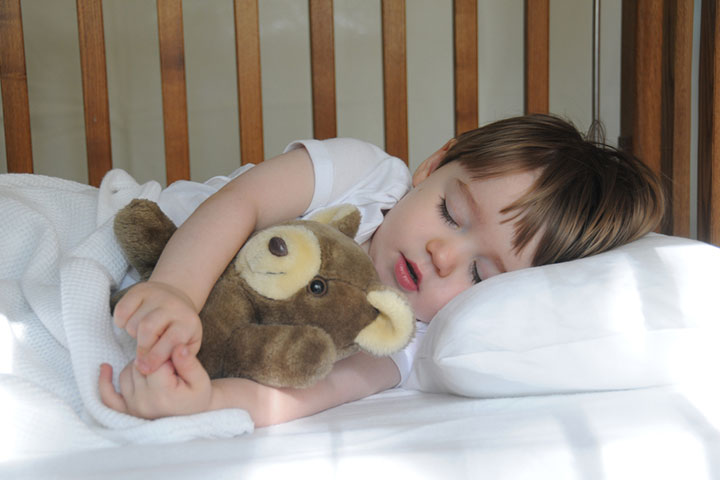
Image: Shutterstock
Toddlerhood is a very unique and curious phase in a kid’s life. And if you’ve ever spent time around these tiny humans, you’ll know that they have a habit of clinging onto their caregivers just like a panda onto a tree. But why, you may ask? Is it because they love us so much? Or because they’re secretly trying to steal our warmth and energy?
Well, in this article we’ll throw light on this behavioral display shown by the little ones and also on how to deal with it without making them feel unwanted or insecure.
Why Do They Become So Clingy?
Toddlers become clingy for a variety of reasons, but no matter the cause, it can be an incredibly difficult experience for parents. One reason toddlers may become so attached is that they have recently experienced a major change in their life, such as, starting daycare or having a new sibling arrive at home. This type of transition often causes anxiety and insecurity which leads them to seek more comfort from their caregivers than usual.
Toddlers also become clingy because they are learning to establish trust, build relationships, and gain independence from their parents or guardians. When toddlers first enter the world, they don’t know who to trust or how to navigate unfamiliar situations on their own. As such, clinging to familiar people provides them with comfort during times when everything else feels overwhelming and uncertain. It also helps them form strong attachments with those around them that will help shape future relationships as well as provide a sense of safety in new environments outside the home setting.
How To Deal With A Toddler’s Clinginess?
Dealing with a toddler’s clinginess can be difficult for parents, but there are some strategies you can use to help your child feel more secure.
1. Understand Their Behavior
It is important to remember that this behavior is normal and not something to worry about. Toddlers often experience separation anxiety as they start exploring their independence and forming attachments with those around them. It’s essential to provide comfort in these moments by being patient and understanding when your child needs extra attention or reassurance from you that everything will be okay.
2. Encourage Them Often
Another way of dealing with clinginess is through positive reinforcement when the toddler does take steps towards independence, without needing too much parental support or assistance. Encouraging words like “I am so proud of how bravely you did this on your own!” will let them know they have done well while also reinforcing the idea that they do not need a constant parental presence to succeed at tasks or activities outside the home environment such as playing at a park, going grocery shopping, etc. This kind of positive reinforcement helps build confidence which could eventually lead to less clinging behavior over time if consistent messages are communicated throughout each day/week/month etc.
3. Maintain A Safe Environment
Creating an environment where toddlers feel safe and secure is key for helping manage their clingy tendencies. Having certain routines such as bedtime rituals (e.g., reading stories together) provides familiarity which may make it easier for children who struggle with transitions during times away from parents due to fearfulness associated with changes in routine (i .e., starting school).
4. Help Them Socialize
Sometimes clinginess can come from a lack of socialization. Make sure your toddler has plenty of opportunities to interact with other children, whether that’s through playdates, preschool, or other activities. So don’t forget to take them to parks and playgrounds to help them join other young ones and have a good time.
5. Offer Them Reassurance
Clinginess often comes from a need for comfort and reassurance, so make sure you’re offering plenty of both. Hold your toddler when they need it, offer words of encouragement and praise, and let them know you’re there for them. For example don’t hesitate to say, “I know you’re feeling scared right now, but I’m here with you and everything is going to be okay. You’re so brave!” Such reassurance will make them feel more comfortable and confident about themselves.
6. Be patient and consistent
Dealing with a clingy toddler can be frustrating, but it’s important to be patient and consistent. Remember that your child is still learning and growing, and they need your support and guidance. Try to stay calm and reassuring, even when you’re feeling overwhelmed. With time and patience, your child will become more confident and independent.
7. Practice The Goodbyes
By practicing goodbyes beforehand, your toddler will know what to expect, and they’ll be less likely to act clingy or upset when it’s time for you to leave. It’s also important to remember to keep your goodbyes brief and positive, and to give your toddler plenty of love and attention when you’re together.
Toddlers deserve all the attention and love in the world but this might lead them to be too attached or dependent on you, making them behave improperly when you are not around. But parents can help their toddlers navigate this phase and grow into confident, independent individuals using the right strategies effortlessly. Let us know in the comment section below how’d you cope with your little one’s tantrums.

















